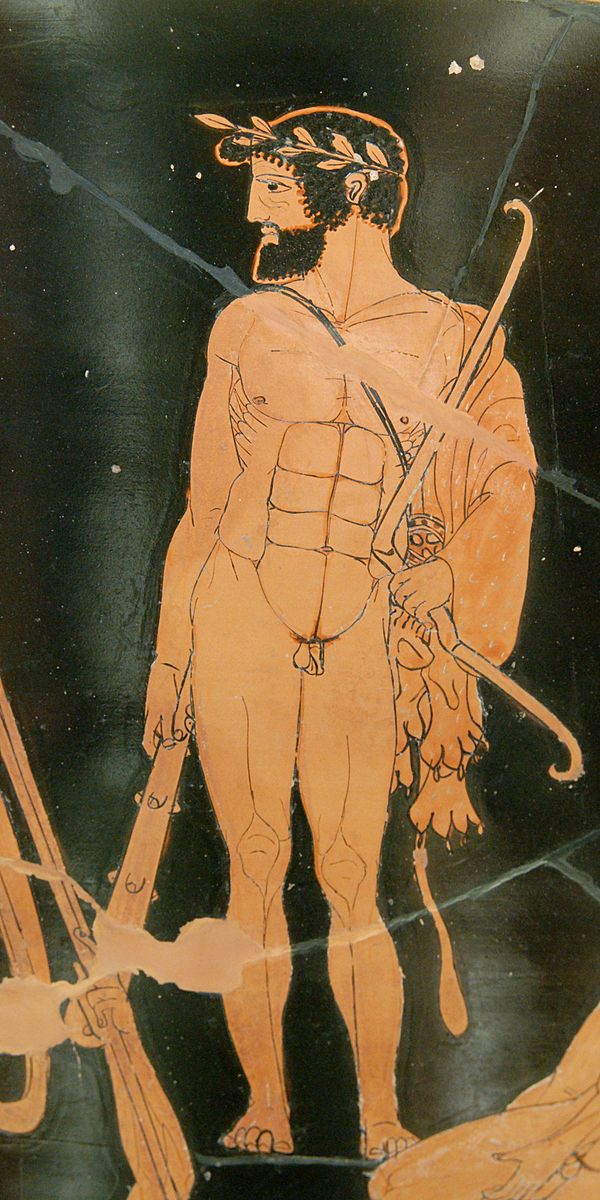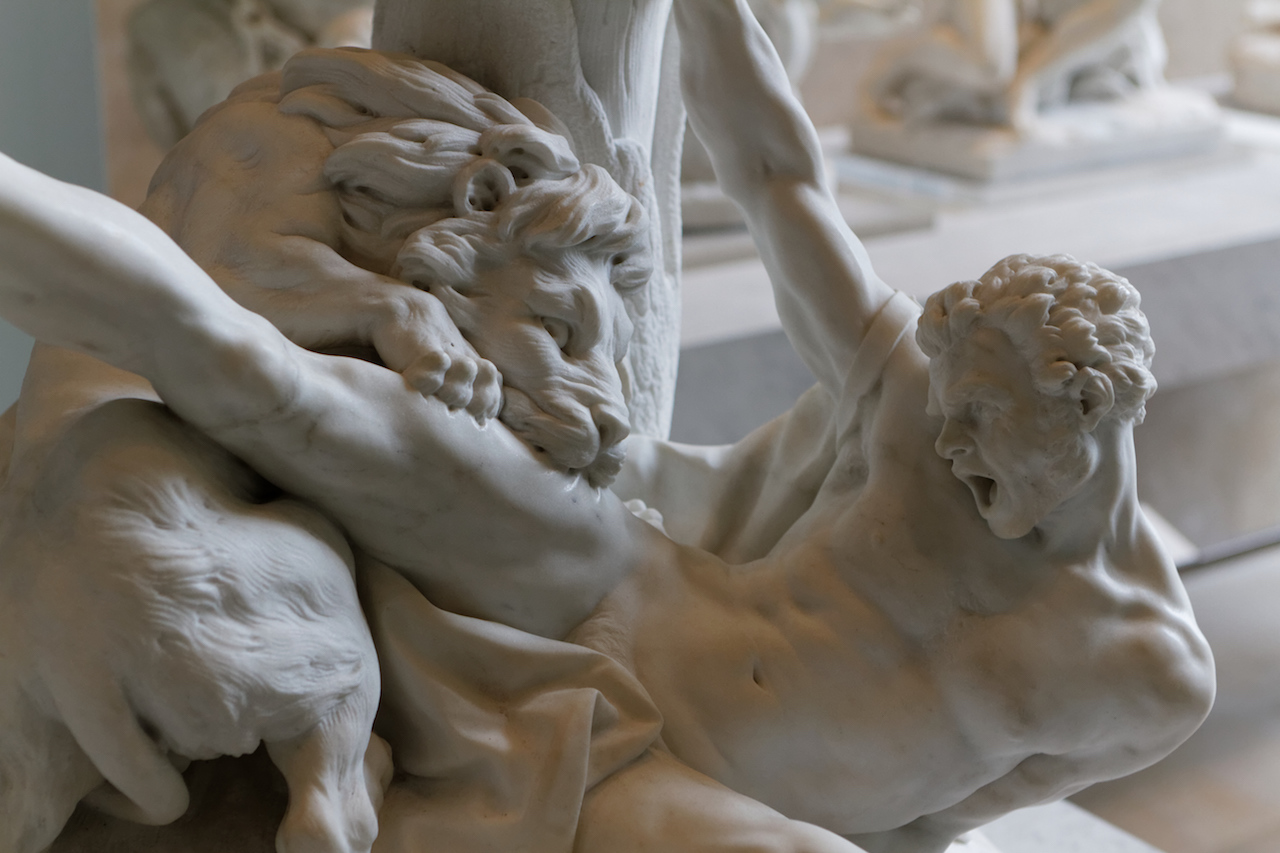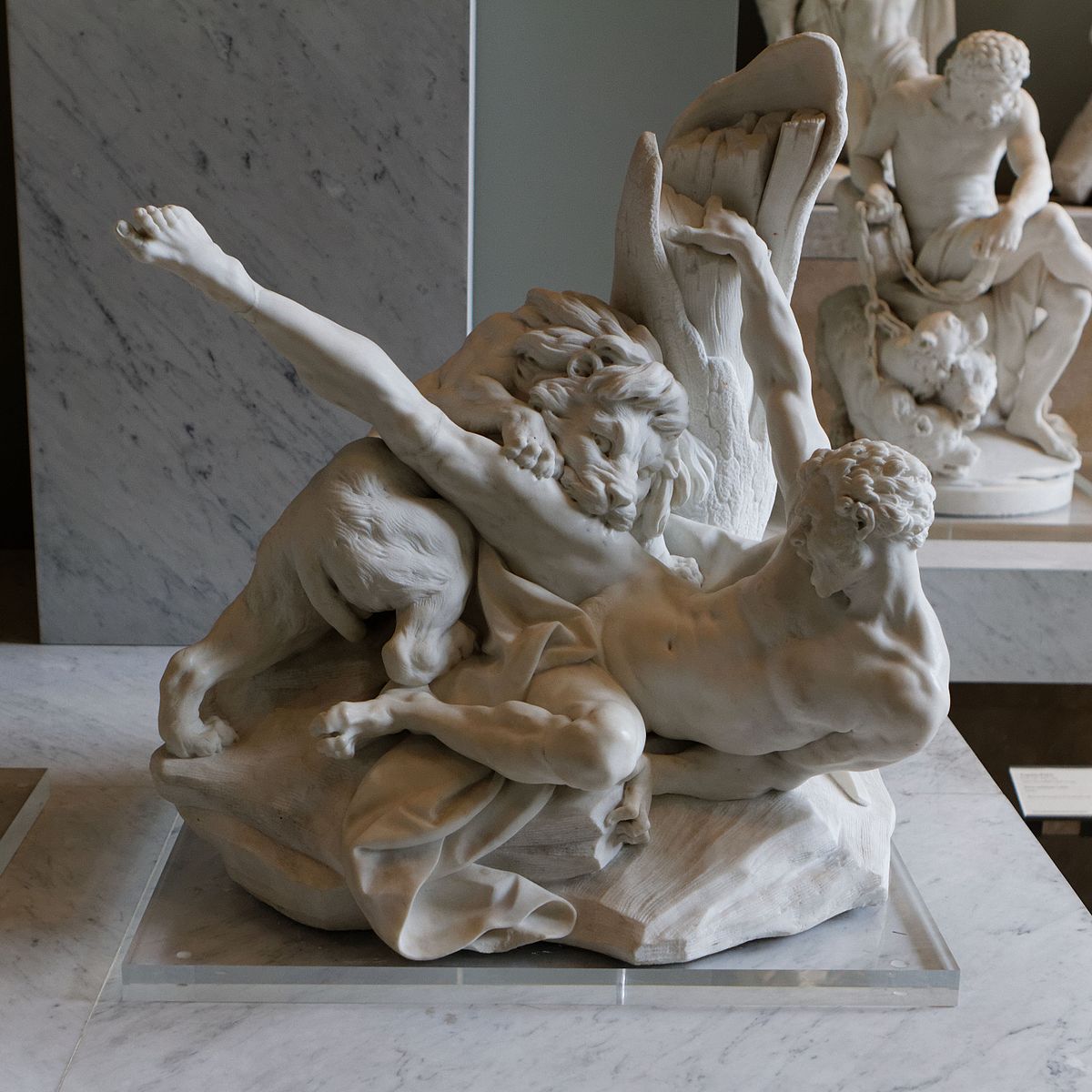for 2022.08.29 | By Gregory Nagy
§0. I rewrite here what was once a self-standing essay (Nagy 2019.05.10) written in honor of Marcel Detienne. I had been inspired by an article published by a young Detienne, back in 1960, concerning a man whom I now describe as an Olympian man. He was Milo of Croton, a famed athlete who modeled himself on Hēraklēs as the ultimate hero of the Olympics. The present version of my essay is no longer self-standing, since it depends on the arguments I presented in the previous essay about the athleticism of Hēraklēs as a “master of animals,” but the centerpoint of the essay remains the same Olympian man who was the centerpoint of my original essay.

§1. In the picture that introduces my essay, we see an ancient representation of the hero Hēraklēs, model for the athlete Milo of Croton. This picture comes from “Side A” of an Attic red-figure calyx-krater, dated 460–450 BCE, which was found in Orvieto and is now housed in the Louvre. In what follows, I will analyze four visual markers we see in this picture of Hēraklēs, and the first three of these markers are directly relevant to an argument once made by Marcel Detienne (1960) about Hēraklēs:
1.Hēraklēs holds a club in his right hand.
2. Hēraklēs wears the skin of the Nemean Lion.
3. Hēraklēs wears a garland made from wild olive leaves (as I argue—so, not from the leaves of the laurel bush, as we read in the museum catalogue); and, as we read in Pausanias (5.7.7) it is said that Hēraklēs was the culture hero who introduced the custom of awarding a garland of wild olive leaves as the prize to be won by victors at the Olympics.
4. Hēraklēs holds a bow in his left hand.
§2. I have two more pictures to show, immediately below. They are both photographs, taken from two different angles, of a non-ancient representation of the athlete Milo of Croton. It is a marble sculptural ensemble, dating from 1754 and created by Étienne Maurice Falconet. This work of art, like the ancient vase painting that I already showed above, is likewise housed in the Louvre. I show here the two photographs of the sculpture, featuring Milo in a pose that conveys the final agonizing moments of a most painful death.


§3. So, what does the representation of Milo in this modern piece of sculpture have to do with the representation of Hēraklēs in the ancient painting? Here is where the article of Detienne (1960) becomes pivotal. As he argues, and most persuasively so, Milo of Croton was a follower of Pythagoras, and, precisely because he was a follower, he modeled himself on the hero Hēraklēs. The article of Detienne (1960) highlights, as the starting point for his argumentation, a remarkable narrative about such modeling in the context of an enormous battle that took place in 510 BCE between two leading cities in Magna Graecia, namely, Sybaris and Croton. The source for this narrative is the historian Diodorus of Sicily, who as we have seen lived in the first century BCE. Here is what is narrated by Diodorus (12.9.5–12.10.1):
στρατευσάντων δ’ ἐπ’ αὐτοὺς τῶν Συβαριτῶν τριάκοντα μυριάσιν ἀντετάχθησαν οἱ Κροτωνιᾶται δέκα μυριάσι, Μίλωνος τοῦ ἀθλητοῦ ἡγουμένου καὶ διὰ τὴν ὑπερβολὴν τῆς τοῦ σώματος ῥώμης πρώτου τρεψαμένου τοὺς καθ’ {12.9.6} αὑτὸν τεταγμένους. ὁ γὰρ ἀνὴρ οὗτος, ἑξάκις Ὀλύμπια νενικηκὼς καὶ τὴν ἀλκὴν ἀκόλουθον ἔχων τῇ κατὰ τὸ σῶμα φύσει, λέγεται πρὸς τὴν μάχην ἀπαντῆσαι κατεστεφανωμένος μὲν τοῖς Ὀλυμπικοῖς στεφάνοις, διεσκευασμένος δὲ εἰς Ἡρακλέους σκευὴν λεοντῇ καὶ ῥοπάλῳ· αἴτιον δὲ γενόμενον τῆς νίκης {12.10.1} θαυμασθῆναι παρὰ τοῖς πολίταις.
When the men of Sybaris, 300,000 of them, collided in battle with the men of Croton, who were 100,000 in number, the leader of the men of Croton was Milo the athlete [āthlētēs], and, by way of the overflow in his bodily strength, he was the first to turn the tide of battle against the enemy ranks facing him. And that was because this man, who had won six victories in the Olympics, and who had an inner-force [alkē] that matched his physique, is said to have faced the battle while crowned with six garlands that he had won in the Olympics and while outfitted, in the mode of Hēraklēs, with a lionskin and a club. Having become the one-who-was-responsible [aitios] for the victory, he was admired as a wonder by the citizens [of Croton].
§4. This battle between the Sybarites and the Crotoniates effectively finished off the defeated city of Sybaris, which was now destroyed by the victorious city of Croton. And the man who had urged the Crotoniates to initiate the battle in 510 BCE, as it is made explicit in an earlier part of the narrative of Diodorus (12.9.4), was Pythagoras, who was at the time a dominant political and cultural figure in the city of Croton.
§5. In a separate article, Detienne (1970) has shown that the teachings of Pythagoras about dietary norms, traditionally linked with vegetarianism (Diogenes Laertius 8.20), seem to have been compatible with symmetrically opposite norms of dieting for warriors and athletes as represented by Milo of Croton: this follower of Pythagoras ostentatiously presented himself as a superhuman carnivore, and there are many different ancient stories about Milo’s prodigious cravings for meat, especially for beef and veal (I cite here just one example of such reportage, Athenaeus 10.412e–f). Here too we can see an example of Milo’s modeling himself on Hēraklēs, who is celebrated as a founder of the practice of sacrificing cattle (Timaeus FGH 566 F 164 via Diodorus 5.4.2).
§6. In stories about Milo of Croton, his attempts to model himself on the hero Hēraklēs can also be seen as the cause of his own undoing. Here I circle back to the sculptural ensemble that I highlighted in §2, where we see a visual retelling of an ancient story reported by Strabo (6.1.12 C263): it is said that Milo, all alone in the wilderness, came upon the stump of a mighty tree, and he felt so challenged by the fact that wedges had been driven into a crack in the stump that he inserted his hand in order to split the stump completely in two, but the wedges fell out and the crack snapped shut on his hand, trapping him: along came a lion that then attacked and devoured the mighty athlete. There is another variant of this story in Pausanias 6.14.8, but I like better the version that I just retold, where the attacking beast is pictured as a lion. I see here an ironic ending for a man who had worn the lionskin of Hēraklēs in the proudest moment of his life, in the victory of the men of Croton against the men of Sybaris.
§7. Before I draw this brief essay to a close, I signal two details about Milo and Hēraklēs.
§7.1. The first detail is about Milo. When I read, in the story of Diodorus (12.9.5–12.10.1), that Milo wore on his head six Olympic garlands when he led the men of Croton in the battle against the Sybarites, I am reminded of a comparable detail in a passage I found in Plato’s Ion (535d) where the rhapsode Ion is pictured as already wearing a golden garland while he is competing for first prize at the festival of the Panathenaia in Athens. I infer, then, that competitors, whenever they competed in whatever competitive ordeal, could wear garlands they had won in previous competitions.
§7.2. The second detail is about Hēraklēs himself. In the ancient painting, shown between §0 and §1, where we see Hēraklēs pictured with a club and a lionskin and an Olympic garland, he is holding a bow in his left hand. I think that the last of these four details is comparable to the bow held in the left hand of the central figure we see in the sculptural ensemble of the West Pediment in Olympia (details about this bow in Ashmole and Yalouris 1967:17). As I already indicated in Essay 4§7, anticipating Part II Essay 4 and Essay 5, I think that this central figure may actually represent a youthful Hēraklēs.
Bibliography
Ashmole, B., and Yalouris, N. 1967. Olympia: The Sculptures of the Temple of Zeus. London.
Detienne, M. 1960. “Héraclès, héros pythagoricien.” Revue de l’histoire des religions158:19–53. https://www.persee.fr/doc/rhr_0035-1423_1960_num_158_1_9059.
Detienne, M. 1970. “La cuisine de Pythagore.” Archives de sociologie des religions29:141–162. https://www.persee.fr/doc/assr_0003-9659_1970_num_29_1_1840.
Nagy, G. 2018.10.11. “About Greek alētheia ‘truth’: Marcel Detienne challenges Martin Heidegger.” Classical Inquiries. https://classical-inquiries.chs.harvard.edu/about-greek-aletheia-truth-marcel-detienne-challenges-martin-heidegger/.
Nagy, G. 2019.04.19. “About a defeat of the Centaurs, and how to imagine such an event in Olympia.” Classical Inquiries. https://classical-inquiries.chs.harvard.edu/about-a-defeat-of-the-centaurs-and-how-to-imagine-such-an-event-in-olympia/.
Nagy, G. 2019.05.10. “On Herakles as a model for the athlete Milo of Croton.” Classical Inquiries. https://classical-inquiries.chs.harvard.edu/on-herakles-as-a-model-for-the-athlete-milo-of-croton/.